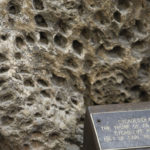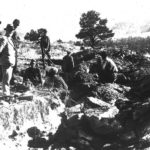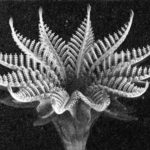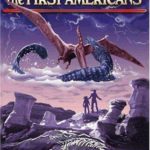By Adrienne Mayor (monthly contributor)
Fossil Cycad National Monument in the Black Hills of South Dakota, established 1922, is the only national park that had to be abolished due to total depletion of the natural resource it was supposed to protect.
The 320-acre petrified forest was one of the world’s largest concentrations of fossil cycads, trees that resembled giant ferns in the Cretaceous dinosaur epoch.
In Sioux mythology, the petrified forests and the barren badlands were evidence of a great catastrophe in deep time, when Thunder Beings fought Water Monsters with lightning and started raging forest fires (Lakota Sioux interpretation of fossils: museum texts written for the Journey Museum, Rapid City, SD, by Birgil Kills Straight of Kyle, Pine Ridge Reservation, and Ronnie Theisz of Black Hills State University, Spearfish, SD).
 The “forest of solid stone at the head waters of the Chayenne River” was first described in 1811 by the Hunt Expediton in Dakota Territory. The description enchanted Edgar Allan Poe, who described the eerie fossil forest in one of his stories. In 1892, F. H. Cole sent photographs of the forest, which had hundreds of fossilized logs, to the Smithsonian, and the first scientific report was written in 1893.
The “forest of solid stone at the head waters of the Chayenne River” was first described in 1811 by the Hunt Expediton in Dakota Territory. The description enchanted Edgar Allan Poe, who described the eerie fossil forest in one of his stories. In 1892, F. H. Cole sent photographs of the forest, which had hundreds of fossilized logs, to the Smithsonian, and the first scientific report was written in 1893.
In the 1890s, paleobotanist George Wieland, a colleague of the Yale  paleontologist Othniel Marsh, developed an obsession with the fossil forest. Weiland even built a special railroad spur in order to haul away about 1,000 cycad logs to the Yale Peabody Museum in New Haven, Connecticut “for research.” In the late 1800s, about 100 more cycad logs were taken from the site by the American Museum of Natural History (AMNH) in New York, and the South Dakota School of Mines in Rapid City.
paleontologist Othniel Marsh, developed an obsession with the fossil forest. Weiland even built a special railroad spur in order to haul away about 1,000 cycad logs to the Yale Peabody Museum in New Haven, Connecticut “for research.” In the late 1800s, about 100 more cycad logs were taken from the site by the American Museum of Natural History (AMNH) in New York, and the South Dakota School of Mines in Rapid City.
In 1920, Weiland obtained the site under the Homestead Act and offered to turn the land over to the federal government. But when the site was established as Fossil Cycad National Monument in 1922, scientists were compelled to acknowledge that the petrified forest had already been denuded of all visible specimens. In 1935, Weiland returned to excavate numerous logs from underground, too.
Thirty-five years after founding the park, Congress finally recognized that almost all of the fossil cycad trees were actually in New Haven, Congress abolished the park in 1957.
 Notably, the Wikipedia entry for the monument states that “vandals” for destroying or stealing the fossils. Although today the stripping of fossils on public lands is blamed on souvenir hunters, amateur fossil collectors, and commercial dealers, pillaging on a grand scale was done in the late 19th and early 20th century by professional collectors for famous museums. More than 1,000 cycad fossils were removed from the site by Yale Peabody Museum, AMNH, and SD School of Mines. Yet no one can explain where all those fossil trees ultimately ended up. Despite repeated requests for information, I was unable to learn where the Peabody Museum stores the 700 cycad specimens collected by Weiland today; some of the logs were used to decorate his garden. It seems unlikely that AMNH still possesses the 100 cycad fossils they took from the site.
Notably, the Wikipedia entry for the monument states that “vandals” for destroying or stealing the fossils. Although today the stripping of fossils on public lands is blamed on souvenir hunters, amateur fossil collectors, and commercial dealers, pillaging on a grand scale was done in the late 19th and early 20th century by professional collectors for famous museums. More than 1,000 cycad fossils were removed from the site by Yale Peabody Museum, AMNH, and SD School of Mines. Yet no one can explain where all those fossil trees ultimately ended up. Despite repeated requests for information, I was unable to learn where the Peabody Museum stores the 700 cycad specimens collected by Weiland today; some of the logs were used to decorate his garden. It seems unlikely that AMNH still possesses the 100 cycad fossils they took from the site.
In the same era, trainloads of immense logs from Arizona’s Petrified Forest went to the Smithsonian. The practice is now euphemistically referred to as “unchallenged research collecting” by “misguided researchers.” Today, the National Park Service (NPS) cites the Fossil Cycad National Monument as a unique case of paleontological mismanagement.
For further information: Vincent L. Santucci and Marikka Hughes. 1998. “Fossil Cycad National Monument: A Case of Paleontological Resource Mismanagement.” National Park Service Paleontological Research 3: 84-89.
http://www.capjournal.com/news/a-south-dakota-mystery-who-stole-the-fossils-from-fossil/article_a6e3f620-9abb-11e3-a584-001a4bcf887a.html
About the author: Adrienne Mayor is a Research Scholar in Classics and  History of Science, Stanford University. She is the author of “The First Fossil Hunters: Dinosaurs, Mammoths, and Myths in Greek and Roman Times” (2011), “Fossil Legends of the First Americans,” (2005).
History of Science, Stanford University. She is the author of “The First Fossil Hunters: Dinosaurs, Mammoths, and Myths in Greek and Roman Times” (2011), “Fossil Legends of the First Americans,” (2005).
